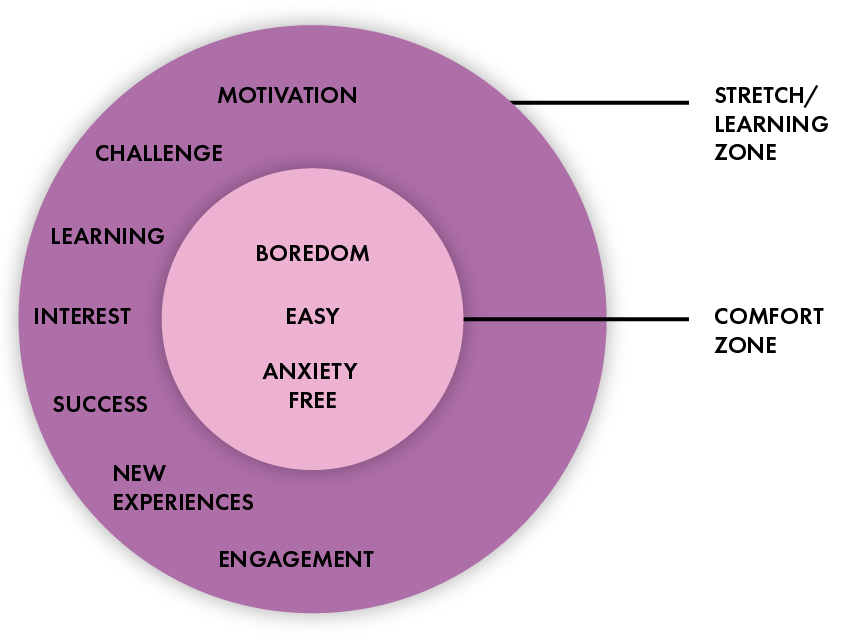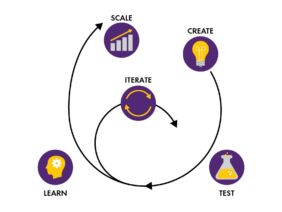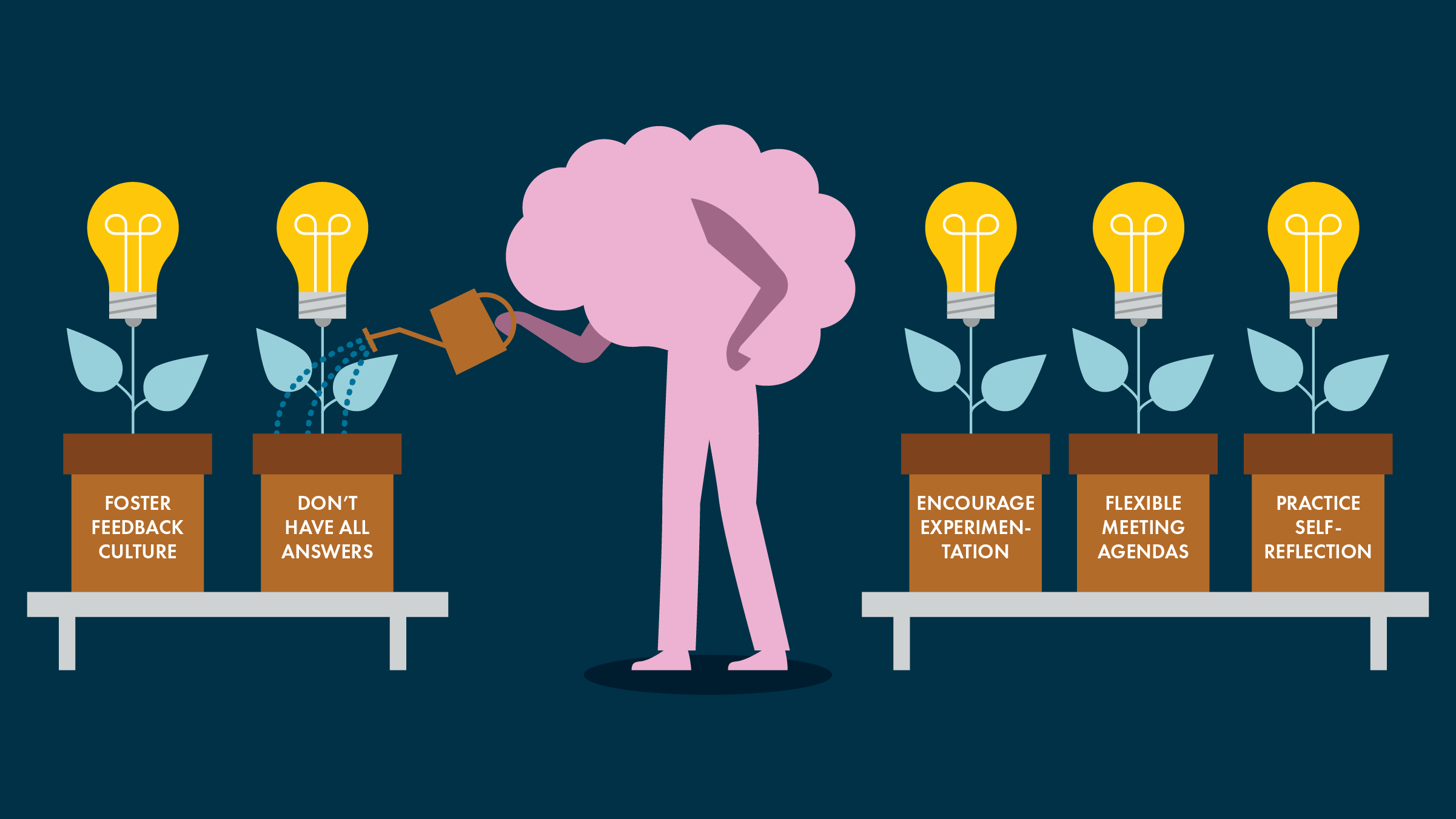Want to become a more resilient, adaptable, effective leader? Nurture a growth mindset! Here are five tips to get you started.
What makes a growth mindset so desirable in modern leaders?
People with a growth mindset see every event as an opportunity to learn and grow, even when things don’t go as planned. They’re more resilient, more adaptable, more self-confident, and more effective at guiding others.
Moving from Comfort Zone to Learning Zone
Practicing a growth mindset requires that you move out of your comfort zone and into your learning zone on a regular basis. The most meaningful growth and development tends to happen in the learning zone.

The Link Between Mindset and Success
In her book, Mindset: The New Psychology of Success, Stanford psychologist Carol Dweck says mindset—the way people approach life’s challenges—sets successful people apart.
Dweck’s studies suggest that people in a growth mindset don’t just seek challenge but thrive on it. “The bigger the challenge,” she writes, “the more they stretch.”
5 Ways to Cultivate a Growth Mindset
Leaders who model a growth mindset create a safe environment for people to try, learn from mistakes, and try again. They make it easy for teams to push boundaries and create better products.
What’s more, they create a space where employees are engaged and excited to do their best work.
To do this well requires humility and vulnerability, which might not come naturally to all leaders.
Like any new habit, adopting a growth mindset requires intention and practice. Here are five ways to develop your growth mindset.
 1. Foster a feedback culture
1. Foster a feedback culture
Growth stems from learning moments, so begin by assessing the current feedback landscape across your team and organization.
Look for regular opportunities to solicit and learn from feedback:
Seek customer or end-user feedback
Put a process in place to ask for customer feedback. Conduct a survey or set up interviews or focus groups. Listen to what your customers are saying, and embrace and act on opportunities to improve.
Conduct regular retrospectives
At the close of every project or event, get the team together to reflect and capture Plus/Delta feedback. Begin with the pluses. What worked well that you want to continue doing? Then capture the Deltas (Delta is the Greek symbol for change). Rather than viewing this as negative feedback, view it as a growth opportunity. What can you do differently next time to improve?
Solicit peer feedback
As part of your annual performance management process, set up a regular practice of getting team members together to share feedback with each other. Every 3 to 6 months, ask each team member to meet with the three to four people they’ve worked most closely with and share Plus/Delta feedback on how they are showing up as a team member. It is much more valuable to receive feedback from those with whom you work most closely, and this approach takes some pressure off the leader to “own” observing and sharing developmental feedback across the team.
Invite diverse perspectives
Whenever possible, invite feedback from a diverse group of people to understand how different people respond to what you are working on. Intentionally ask others to “poke holes” in your product or process. It is fascinating and invaluable to get the perspectives of people who are not closely involved.
Share from a place of support
Fostering a culture of healthy feedback begins with positive intent. Feedback should always be given and received with an eye to growth and improvement. When sharing feedback with others, be sure it is coming from a place of support. When sharing Delta feedback, include specific ideas of ways to improve.
Be open to feedback
When someone is sharing feedback with you, be open to receiving it. Assuming positive intent, if someone is taking the time to share feedback with you, there is a learning opportunity. Listen, learn, and carry the learnings forward.
 2. Embrace that you don’t have to have all the answers
2. Embrace that you don’t have to have all the answers
This extremely valuable leadership trait requires vulnerability. As a leader, it takes courage to be comfortable with not having all the answers. After all, your team looks to you for guidance. But it sends a powerful message when you can openly and honestly say you don’t have the answer—and it is even more powerful when you “crowdsource” the answer from your team.
Be honest if/when you don’t have the answer and ask if anyone else does. If nobody has the answer, capture it as a parking lot item and follow up.
Consider everyone on the team as collaborators. Tap into the unique strengths and expertise each person brings and co-create solutions or strategies together. This creates shared accountability, greater buy-in to solutions, and ultimately a stronger product.
 3. Encourage experimentation
3. Encourage experimentation
Inviting product feedback during the process of designing and building is one important way to adopt a growth mindset. Any opportunity to learn and adjust before things are final ensures a stronger product.
Find ways to test things before they are final. Build prototypes and get feedback from your customers early in the process. Leave room to make changes based on what you learn. Think of ways you can apply this process to what your team is working on.
To facilitate this agile process, leaders need to value progress over perfection. It is OK to make mistakes; in fact, we need to make mistakes in order to learn. Focus on what is learned and how to carry the learning forward to improve. We are all on a learning journey, and that should be seen as positive.
 4. Build flexibility into meeting agendas
4. Build flexibility into meeting agendas
If you plan and lead meetings or workshops regularly, build some flexibility into your agendas. Plan the structure of your session to reach your objectives but leave room to pivot based on what you learn during the meeting. While you may have a specific route planned to reach your objectives, you may discover during the meeting that taking a different route is more effective. Participant discussion and ideas might uncover the need to move in a new direction.
Having a growth mindset means that you intentionally invite participant feedback and are open to changing course if it leads to a better participant experience and end result. Effective facilitators can find the balance between sticking to their agenda while also being in the moment to observe, listen, learn, respond, and adjust as needed.
For longer meetings/workshops, find places during the session to pause and check in with participants on their experience. For shorter meetings, find a way to ask participants for Plus/Delta feedback at the end of or after the meeting. This is an exciting opportunity to learn something new and sharpen your skills each time you facilitate.
 5. Practice regular self-reflection
5. Practice regular self-reflection
In addition to seeking and listening to feedback from others, it is equally important for leaders to plan time for self-reflection.
Begin by making a list of your leadership values. Consider:
- What type of leader do you want to be?
- How do you want to show up and/or be perceived?
- What kind of energy do you want to bring?
At the end of each week, take 15 minutes to reflect on all the events and activities that took place over the last few days.
Begin with the PLUSes:
- What did you do well this week that aligns with your leadership values?
- What behaviors do you want to intentionally continue?
Then think about DELTAs:
- Where did you have learning moments?
- What can you do differently to improve?
Focus more on the specific learnings, actions, or behaviors you want to carry forward, and focus less on things that didn’t go as well as you’d hoped. “Even in the growth mindset,” states Carol Dweck, “failure can be a painful experience. But it doesn’t define you. It’s a problem to be faced, dealt with, and learned from.”
A Habit Worth Developing
Remember, to be in a growth mindset takes intention and practice. These five tips can help propel you in the right direction.
When leaders continually look for new ways to make a growth mindset a habit—and create a healthy learning environment for all—they set teams and organizations on the path to learning, creativity, persistence, and success.
It’s important for leaders to continually look for new ways to make it a habit and create a healthy learning environment.
Additional Information
For additional content, we recommend the following blog post:
